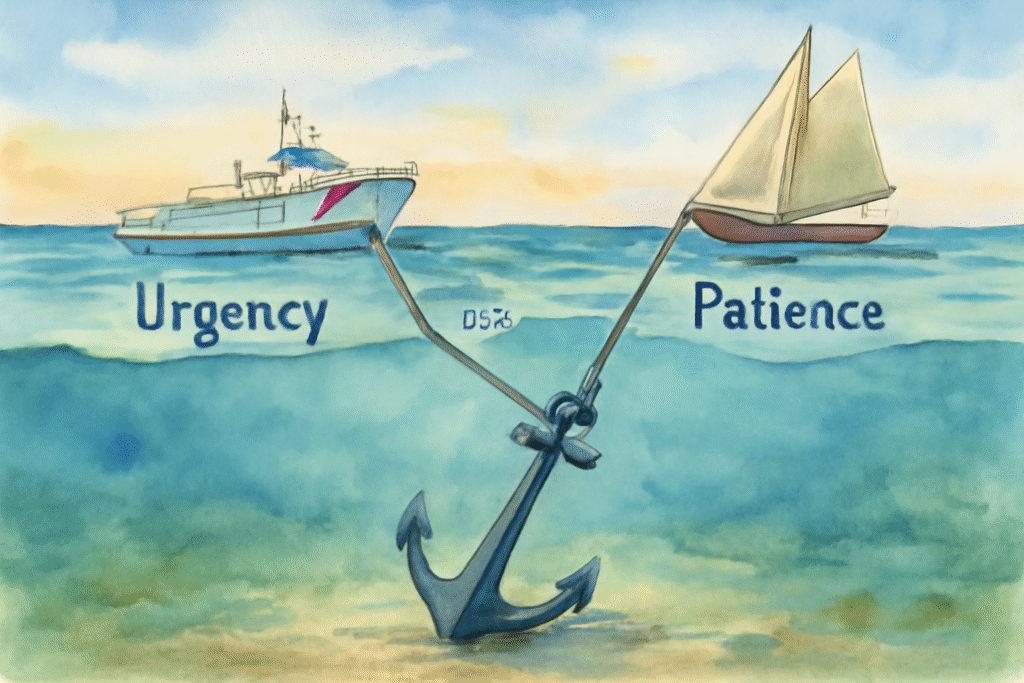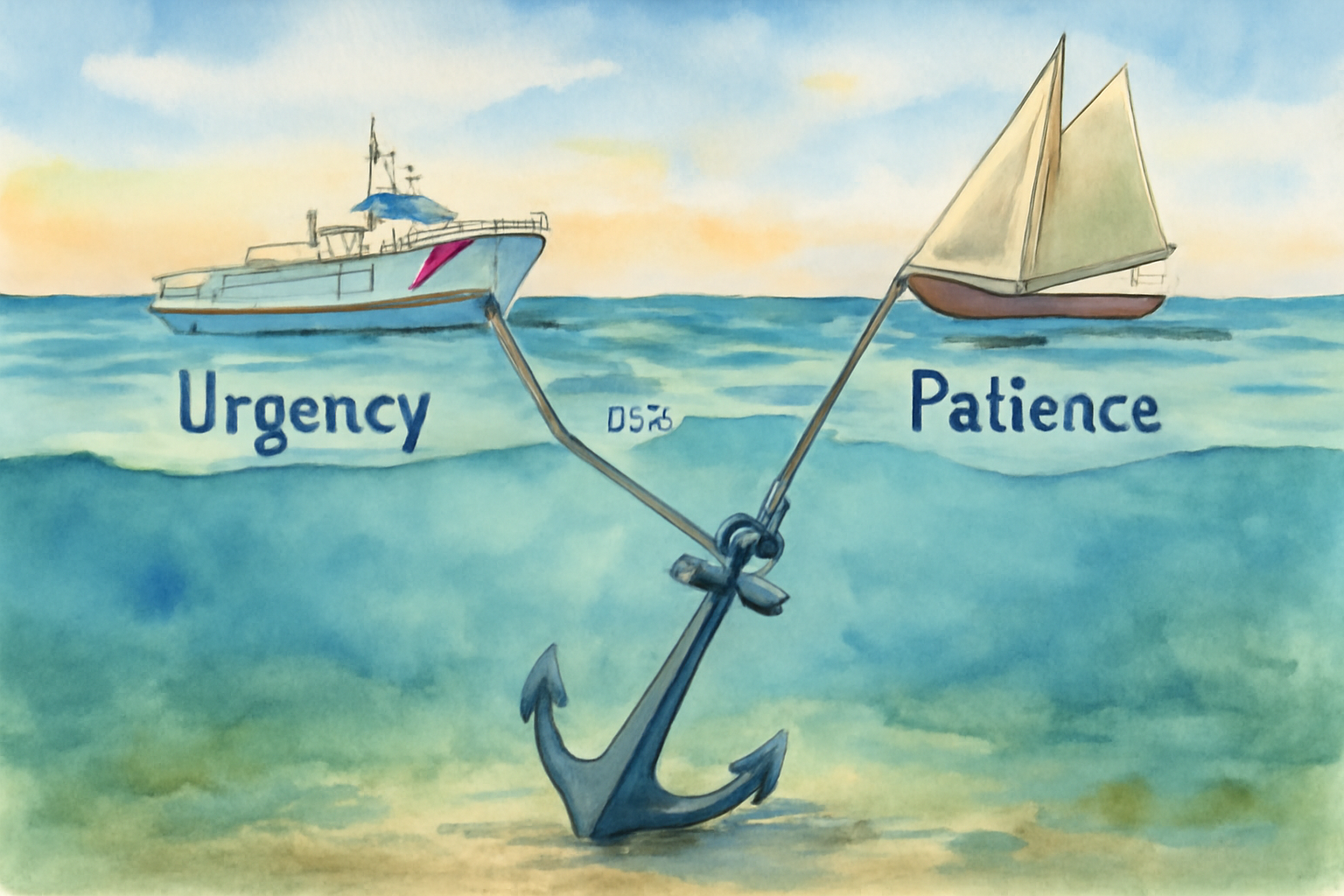The DG’s Critical Position
Directors General (DGs) hold a pivotal role in public sector transformation. Positioned between Assistant Deputy Ministers (ADMs) who set strategic directions and Directors/Managers who execute operational plans, DGs are often the anchor point where urgency and patience must be reconciled.

While ADMs translate political vision into departmental strategies, DGs are responsible for making it real—ensuring programs, projects, and staff deliver results that both meet urgent demands and withstand the test of time. They manage budgets, oversee implementation, and act as the practical link between high-level strategy and ground-level execution.
This blog explores how DGs can act as effective anchors in transformation, sustaining momentum by balancing the immediate need for results with the long-term patience required for cultural and structural reform.
Urgency in the DG’s World
For DGs, urgency shows up as:
- Performance pressures: delivering milestones on time and within budget.
- Accountability reporting: preparing results frameworks, Treasury Board submissions, and performance dashboards.
- Ministerial optics: producing outputs that can be showcased as success stories in annual reports, speeches, or media engagements.
DGs often face deadlines that are politically driven but operationally challenging. They must align project realities with expectations that often move faster than institutional processes allow (Aucoin, 2012).
Patience in the DG’s Reality
At the same time, DGs recognize the need for patience. Programs and reforms require:
- Complex coordination across branches, central agencies, and stakeholders.
- Staff adaptation to new systems, processes, and cultures.
- Iterative refinement when pilots reveal gaps or unintended consequences.
Without patience, DGs risk rushing implementation, resulting in breakdowns, rework, and staff burnout. Yet without urgency, transformation loses political support and organizational momentum.
This tension creates what Kotter (2012) describes as the “dual operating system”: balancing the need to move fast with the reality of bureaucratic stability.
DGs as Anchors of Transformation
DGs serve as stabilizing forces in transformation. They anchor urgency and patience in four key ways:
- Operational Translators
DGs interpret ADM directives into actionable plans for Directors and teams. They break down high-level priorities into manageable phases while maintaining alignment with political timelines. - Capacity Protectors
DGs monitor the bandwidth of their branches, ensuring workloads are realistic and that staff development is prioritized alongside delivery. They prevent urgency from overwhelming institutional capacity. - Momentum Sustainers
DGs maintain project rhythm by sequencing milestones. Small wins demonstrate urgency, while steady progress builds long-term credibility. - Cultural Stewards
DGs shape workplace culture through their leadership. By modeling disciplined urgency and deliberate patience, they reinforce resilience, trust, and adaptability in their teams (Denhardt & Denhardt, 2015).
Strategies for DG Leadership in Transformation
DGs can employ several practical strategies to balance urgency and patience:
1. Milestone-Based Planning
Break transformation into short-term deliverables tied to visible outputs, alongside long-term structural goals. This dual horizon planning maintains both credibility and continuity.
2. Deliberate Communication Channels
DGs should over-communicate with Directors and Managers, clarifying which tasks require urgency and which demand patience. Differentiating “fire drills” from “slow burns” prevents confusion and fatigue.
3. Empowered Middle Management
By equipping Directors with authority and resources, DGs distribute leadership. This creates bandwidth for DGs to manage both the urgent and the patient dimensions of reform.
4. Evidence-Based Justifications
DGs can use data and evaluation to push back on unrealistic timelines. Transparent reporting helps temper urgency with grounded realism, sustaining trust with ADMs and central agencies.
5. Adaptive Piloting
Launching pilots allows DGs to show urgent progress while testing reforms before scaling. This satisfies political optics while embedding patience in learning cycles (Heifetz, Grashow, & Linsky, 2009).
Case Example: DG in Service Transformation
A DG responsible for modernizing client-facing services faced urgent demands from the ADM to demonstrate progress within six months.
The DG responded by:
- Launching a limited digital pilot in one region, delivering quick improvements in accessibility.
- Framing the pilot as the first stage in a five-year modernization roadmap, connecting immediate success to a broader reform.
- Using pilot results to inform training and resourcing strategies, ensuring staff capacity was not undermined.
This approach satisfied urgency by producing visible results while honoring patience by building sustainable momentum.
Risks of Imbalance for DGs
If DGs emphasize urgency too heavily:
- Teams burn out, leading to attrition and diminished performance.
- Quick fixes break down, damaging credibility with citizens and Ministers.
- Oversight bodies identify risks and gaps, undermining future approvals.
If DGs lean too heavily on patience:
- ADMs and Ministers perceive inertia or resistance.
- Transformation loses visibility, making it vulnerable to shifting priorities.
- Momentum stalls, leaving reforms incomplete.
The DG’s art is finding the equilibrium where urgency inspires action and patience sustains capacity.
The Human Dimension: Leading People Through Change
Transformation is ultimately about people. DGs must lead not just processes but emotions:
- Acknowledging anxiety created by urgency, offering clarity and reassurance.
- Recognizing fatigue, pacing workloads to protect mental health.
- Celebrating wins, no matter how small, to keep staff motivated.
- Modeling patience, showing that adaptation takes time and missteps are part of progress.
This emotional intelligence is central to DG effectiveness in sustaining reform cultures (Goleman, 2013).
Building Partnerships for Support
DGs do not carry the paradox alone. They can leverage support from:
- ADMs, by negotiating realistic timelines and resource allocations.
- Central agencies, by aligning reporting with achievable deliverables.
- Independent facilitators, who provide frameworks, coaching, and neutral assessments to support balance.
By cultivating partnerships, DGs strengthen their role as anchors who stabilize transformation without being immobilized by pressure.
Conclusion: DGs as Anchors of Transformation
DGs sit at the center of transformation, responsible for translating strategic urgency into operational patience. Their leadership determines whether reforms collapse under political speed or stagnate under bureaucratic caution.
By modeling disciplined urgency, sustaining momentum, and protecting institutional capacity, DGs anchor transformation in both credibility and resilience.
The paradox is not a burden but a strength: when DGs balance urgency and patience, they become the steady hands that make transformation possible.
What’s Next?
Institute X equips ADMs to thrive in the paradox of urgency and patience, offering frameworks, facilitation, and coaching that strengthen leadership and build resilient transformation cultures.
References
- Aucoin, P. (2012). New Political Governance in Westminster Systems. Public Policy Forum.
- Denhardt, J. V., & Denhardt, R. B. (2015). The New Public Service: Serving, Not Steering. Routledge.
- Goleman, D. (2013). Focus: The Hidden Driver of Excellence. HarperCollins.
- Heifetz, R. A., Grashow, A., & Linsky, M. (2009). The Practice of Adaptive Leadership. Harvard Business Review Press.
- Kotter, J. (2012). Leading Change. Harvard Business Review Press.

